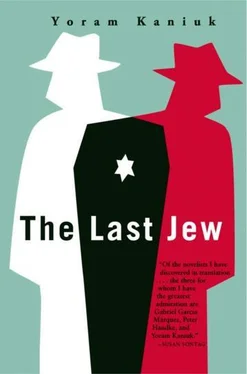What stands out in Ebenezer is the lack of individuality in the accepted sense of the word. One of our investigators called him "a man without qualities" from Musil's well-known book. But that of course is only one aspect and does not characterize his personality. His love for his wife Dana and for Samuel Lipker is not the love of a man without qualities. His life is made of too many libels for him not to be aware of some of them. After he spent time in several camps, he was taken to Hathausen and was the first prisoner there and even helped build the camp. From what we know, it was his skill in the art of carpentry that kept him alive.
For a few weeks we observed his work and although at first he refused to get involved again with carpentry, he eventually agreed to show us his handiwork. He was ordered by our investigator to build a small pipe rack. For two weeks we observed his production. Clearly the final shape wasn't clear to him; the rack resulted from a need called in this report "particular," that is: to be this rack and no other, and that a metaphor of a wellknown concept. Ebenezer built drawers for pipecleaners, matches, of various sizes, he lined the concavity with green cloth, he used forty-two different lacquers he created from solutions of glue powder and other materials. He skillfully planed tiny pieces of wood and interwove them in a marquetry: the rack was the product of many combined details (things Ebenezer apparently imagined, but didn't know) and the product was a rack of restrained beauty and uniqueness. We sent the rack to four different museums (in Amsterdam, Vienna, Berlin, and London), and the unanimous opinion was that this is an excellent rack, the handiwork of an early nineteenth-century artist. Dr. Rosenberg of Vienna, the greatest expert in European cabinetry of the period 1795–1838, mentioned the names of only two artists who were capable of building that rack and claimed that we had presented him an absurd riddle, since he knew every rack made by those artists, while an imitation of the rack of those artists was impossible. Thus it is hard to argue that Ebenezer Schneerson is a man without qualities.
After we collected other works by Ebenezer, in the homes of former SS officers, we made a small exhibition of his works. The exhibition was presented only in our research institute. We wanted to print a modest booklet in honor of the event, but Ebenezer refused, saying that only Samuel Lipker had the right to do that.
His story in the camp (and his survival as a carpenter, if what he produced can be called carpentry) is told in the expanded research. What can be said positively is that there was a certain moment when Ebenezer decided to give up being the Last Jew in the world. Out of an empathy he developed for his imprisoned companions, fear that many geniuses and scholars, writers, and researchers would die without leaving a trace of their knowledge. In our work with him we have penetrated to only a certain area of investigation of his memory. In his hallucination under hypnosis he told us how he once sat in a woman's house, a woman he apparently respected and maybe even had relations with, and hated himself for what he called his betrayal of Dana. At night he sat in a little room, he told us, and tried to recall Dana. Her precise image eluded him. All he could remember was a vague form of a woman. He felt a need to remember her exactly as she had been, something that's hard for the human memory to do. He had no photos. So he sat, stared at the burning oven, concentrated and very slowly remembered a small dimple in Dana's right cheek. He meditated on the dimple for a long time until it was completely clear in his memory. Then, he left it and meditated on her nose. When the nose was clear, he left it for a while and the mouth began to be drawn in his mind and only then he connected the dimple in the cheek and the cheek to the nose and the mouth and did he connect the throat to the orbits of the eyes and come to the hair, which at first was separated from the other parts of the face and joined to them, and so, very slowly, Dana's image was drawn like a crossword puzzle that became a precise photo he'd see before his eyes. Her legs, for example, he recalled when he thought about the hike they had once taken to the desert and Dana tripped and he smeared the wound with medicinal leaves he had learned from the Bedouins. Ever since then, he said, Dana appears whenever I need to remember her, he shuts his eyes, thinks of the stove and Dana's image rises in his mind. He claims he has many keys he remembers dimly but when he needs them they appear in the back of his mind and through them he remembers things. For example, Einstein's theory of relativity depends on thinking of the smell of roasted coffee. A pince-nez raises before him the entire Pentateuch.
Did he learn to photograph knowledge? It's hard to say since he didn't read the knowledge and if he photographed it, he photographed the voice that recited the knowledge. If so, the word "recorded" will be more appropriate. But that doesn't explain anything. At most it can describe a process whose source remains blocked. According to a representative sample, we measured about nine million words that Ebenezer knew orally. For instance, in nightclubs where he appeared with Samuel Lipker, he often recited lists of those killed in the pogroms of 1915–1919. The knowledge was divided by towns (the key to that knowledge was drummed out by the fire department orchestra in Livorno). Many of the towns he mentioned were wiped off the face of the earth and there is no longer a trace of them on maps. In a forgotten Jewish book titled The Scroll of Slaughter, we found one section he recited almost completely. Of the two hundred pages we copied of our tapes I shall present a few examples: Garbatishi, Kortivo district, Minsk Gubernia, six Jewish families. Granov, Haysen district, Podolia Gubernia (attack of Petlura's Cossacks) eight families, etc….
Or an alphabetical list of the murdered: Golobibsky-Haim Austoroy, fortyfive years old, his son Jacob, seventeen years old, or in one town: Klibanov, Elijah, seventy-one years old, along with his wife Hayke. Israel Zvi Goldenberg, forty-five years old, Israel David Klayman, fifty-five years old, murdered along with his two sons-in-law, Isaac and Samuel… And then: Hanna Gradover, Simha Feinstein, his son Nahman. Lev Austoroy, his wife Sareke, his daughter Rebecca and his son Elijah. Abraham Lapolski, Moshe Kalike, Yosef Krayz, Leah, daughter of Arye Hoykhman. Her husband Yanek and her four children (their names are erased from the tape), Isaac Posman, Meir ben Arye, Parties Hadash… Joseph Joffe… Benjamin ben Elijah… Toni daughter of Haim Serberiazsek, Pisanoy Baruch Beamer…
The number of killed in those towns and villages (only to the letter C) amounts to two thousand one hundred.
The lists of Jewish communities we found at Yad Vashem and other institutions include some of the names mentioned by Ebenezer. We discovered that all the names that appear on tombstones or in lists, in books, in the scrolls of slaughter, also appear in Ebenezer's recital, but there are many names he recites that have no alternative indication.
In one town-fortunately for us, the register of its Jewish community has remained intact-were names of all the Jews who had lived there. Ebenezer recited all their names. After this timing and what was said above, it is clear to us that what he knows, he knew precisely. And there are things only he knows or that we cannot know more than what he knows. Meanwhile, of course…
What made the research even more difficult is the disorder of the knowledge or the illogic in the logic of memory. For some time, we entertained the idea that there was a logic unknown to us in this illogic, but that remained an intellectual amusement. You do know that his encyclopedic knowledge is not systematic at all; books in five or six languages, the Bible, and suddenly brilliant lies about astrophysics (made up by a mad genius), a long solid study refuting Einstein's theory, an atomic structure of the world according to the order of the letters in the Book of Genesis, annals of the world according to a person named Pumishankovitch who argues that God was created after the world and the Torah of the Jews is nothing but an attempt to combine the annals of nature with the annals of antinature, a book about the world as a fallen planet in a system of stars that were extinguished long ago, a rather bold theory about the influence of the battle of Albania on technological development. A hundred and fifty pages of The Jewish Wars by Josephus Flavius in reverse order, books of mythology describing unknown myths documented with knowledge and skill, even though they're apparently fakes. Books of religion and science, journals of three people who tried to measure their love for one another by writing hasty lines in the depths of the earth until they passed out, the stories of Kafka, stories of the Hasids, journeys of the emissaries of the Land of Israel to future generations of the eighth century to the end of the nineteenth century, family trees going back to the first generation, calculations of the end of days according to the books of Daniel, Ezekiel, and Nostradamus, and documents of wars, mathematical theories, the poetry of Homer, the poetry of Virgil, Dante, and other writers I attach in a separate appendix.
Читать дальше












